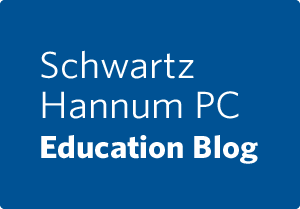By William E. Hannum III
As independent schools, colleges and universities begin the academic year, looking forward to teaching, learning, and growth in the coming year, I want to remind everyone to “Be careful out there!”
In the wake of the Penn State-Sandusky story years ago, New York Times columnist David Brooks offered a sobering reminder that “[u]nfortunately, none of us can safely make that assumption [that we will do the right thing in a moment of crisis]. Over the course of history — during the Holocaust, the Rwandan genocide or the street beatings that happen in American neighborhoods — the same pattern has emerged. Many people do not intervene. Very often they see but they don’t see.”
For that reason alone, we strongly encourage schools to train themselves (students, faculty, and staff) on the kinds of behaviors that are expected at your school, and the kinds of behaviors that are unacceptable. For all educational institutions, this training is an excellent idea.
Now – early in the new academic year – is an ideal time for it. This past July, a New York Times article described the most dangerous stretch for new college students: “the Red Zone, a period of vulnerability for sexual assaults, beginning when freshmen first walk onto campus until Thanksgiving break.”
Of course, for colleges and universities, and other schools that receive federal funding, much of this sort of training is also legally required, under Title IX.
However, age-appropriate training for all students is increasingly recognized as a now-obvious “best practice.” A recent article in the Boston Globe extols the virtues of in-person training, even in middle school, to educate students earlier in their development and maturation: “we should be sending the message earlier — reaching boys in middle school, when the hormones kick in.”
Many SHPC attorneys have just returned from conducting these kinds of trainings for schools (e.g., boundary training for faculty and staff; and anti-bullying, cyber-bullying and appropriate use of social media training for middle school and high school students). These training programs are incredibly well-received by not only the schools, faculty, and staff – but also by the students – as these seminars provide a safe place to talk about challenging situations and sensitive topics.
So, as you look forward to a fantastic year, remember to protect your students, and faculty and staff, as well. Not only during the Red Zone (between now and Thanksgiving), but also for the entire year.
Remind everyone what it means to be careful out there. That way, if something bad does happen, someone among your students, faculty and staff will really see it and know what to do about it.


